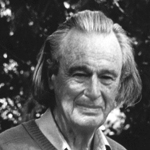Derek Freeman
Derek Freeman (born August 15, 1916 in Wellington , New Zealand , † July 6, 2001 in Canberra , Australia ) was a New Zealand anthropologist and is known for his scientific dispute over the research results of Margaret Mead on the social behavior of the Samoans.
Life
Freeman was the son of an Australian father and a New Zealand mother from Wellington. He attended Victoria University College and studied psychiatry and philosophy with Ernest Beaglehole . Beaglehole introduced Freeman to Mead's research on Samoan societies, which led him to visit Samoa in 1940 to conduct ethnographic studies. Freeman spent most of his three years in Samoa as a school teacher; During this time he learned the Samoan language , was adopted into one of the families and was given the title of chief.
In 1943 Freeman left Samoa to volunteer for New Zealand. He served in the Pacific, where he looked after Japanese prisoners of war in the Navy. During this time he came into contact with the Iban on Borneo , which prompted him to do further field research on Sarawak . In 1949 Freeman married Monica Maitland, with whom he spent 30 months in Borneo.
Freeman returned to England in 1951 and was accepted into King's College , where he completed his dissertation on the Iban in 1953. He then taught at the University of Otago in New Zealand and at the University of Samoa before he was appointed to the Australian National University in Canberra, where he would teach for the rest of his life. In 1966 Freeman returned to Samoa to do psychological and ethnographic research.
Derek Freeman died in Canberra on July 6, 2001.
Controversy with Margaret Mead
Freeman described inconsistencies between Mead's findings and his own observations of the Samoans: “In my early work, as a result of my unconditional recognition of the scriptures, I had been inclined to discard anything that contradicted their findings. By late 1942, however, it became increasingly clear to me that much of what she had written about the people of Manu'a, Eastern Samoa, did not apply to the people of Western Samoa ... Many trained Samoans, especially those who had attended schools in New Zealand , were familiar with Mead's writings on their culture ... (and) they approached me as an anthropologist to correct their erroneous portrayal of the Samoan ethos. "
Freeman conducted research for forty years and finally described his results in 1981 after gaining access to the archives of the American Samoa High Court during the 1920s. Therefore, his refutation was only published after Mead's death in 1978 ( Margaret Mead and Samoa ), which nevertheless made him many enemies. Freeman found that Mead was not only tricked and lied to by local informants, but that she was also consistently blocking out the violent side of Samoan society. He went on to write that Mead, who neither mastered the Samoan language nor resided long enough in Samoa, relied too much on society as a foundation in determining gender roles and completely ignored the biological component. The publication sparked a great scientific controversy, arguably the largest in the history of anthropology.
Fonts (selection)
-
Margaret Mead and Samoa. The Making and Unmaking of an Anthropological Myth . Penguin, Harmondsworth 1983, ISBN 0-14-022555-2 .
- German translation: love without aggression. Margaret Mead's legend of the peaceful nature of indigenous people . Kindler, Munich 1983, ISBN 3-463-00866-1 .
- The Fateful Hoaxing of Margaret Mead. A Historical Analysis of Her Samoan Research . Westview Press, Oxford 1998, ISBN 0-8133-3693-7 .
literature
- Paul Shankman: Culture, Biology, and Evolution. The Mead-Freeman Controversy Revisited . In: Journal of Youth and Adolescence , 29 (2000), pp. 539-556, ISSN 0047-2891
- Donald Tuzin: Derek Freeman. 1916-2001 . In: American Anthropologist / NS , Vol. 104 (2002), pp. 1013-1015, ISSN 0002-7294 .
Web links
- Literature by and about Derek Freeman in the catalog of the German National Library
Individual evidence
- ↑ Translated from the preface by Derek Freeman: Margaret Mead and Samoa. The making and unmaking of an anthropological myth , 1983.
| personal data | |
|---|---|
| SURNAME | Freeman, Derek |
| BRIEF DESCRIPTION | New Zealand anthropologist |
| DATE OF BIRTH | August 15, 1916 |
| PLACE OF BIRTH | Wellington , New Zealand |
| DATE OF DEATH | July 6, 2001 |
| Place of death | Canberra , Australia |
